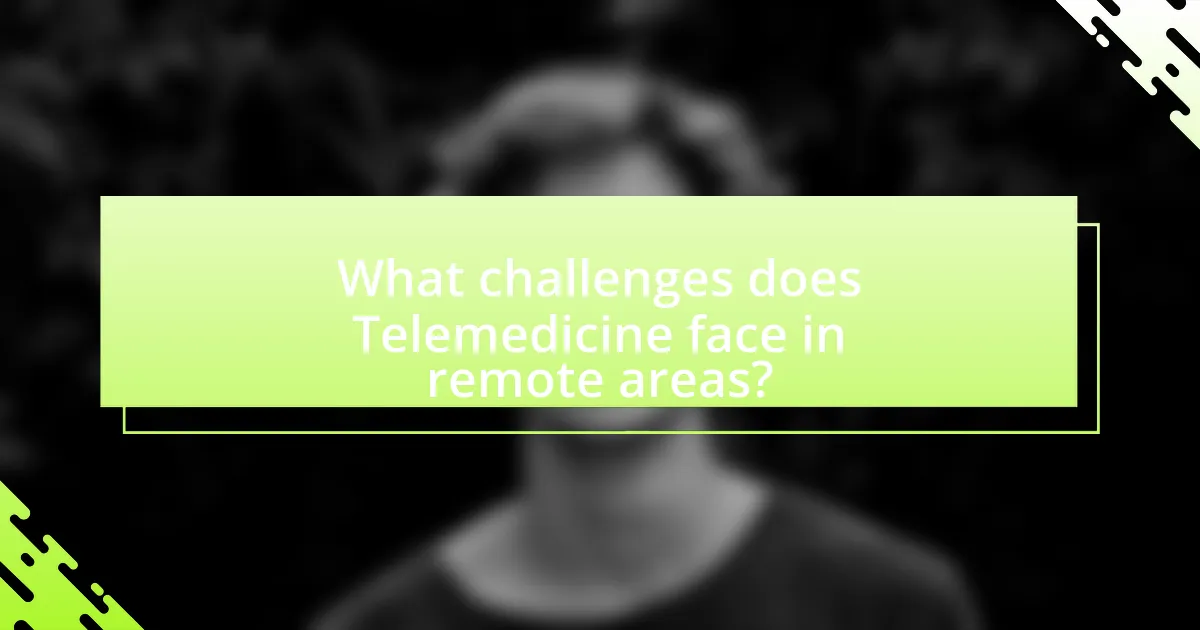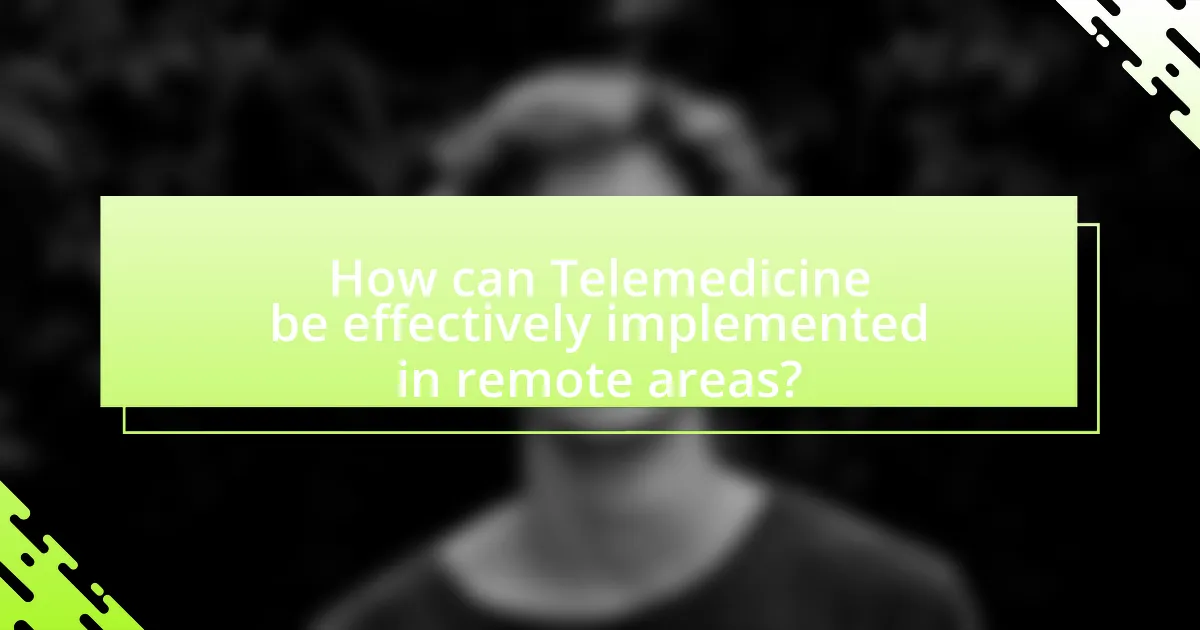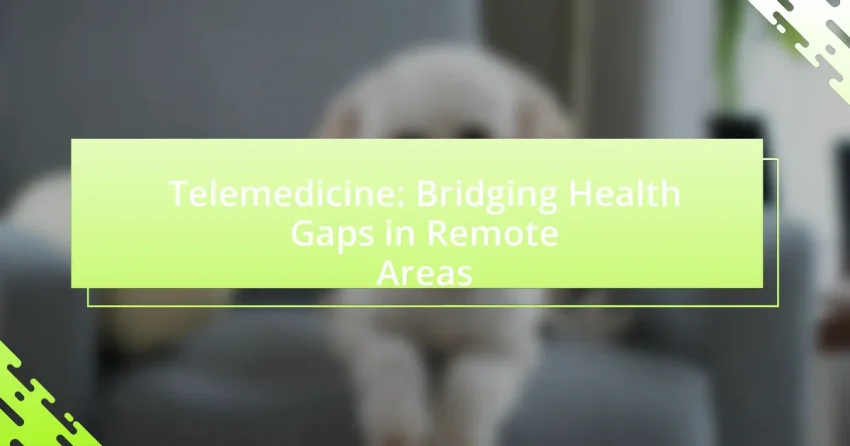Telemedicine is the use of technology to deliver healthcare services remotely, significantly improving access to medical care for individuals in remote and underserved areas. This article explores the functioning of telemedicine in these regions, highlighting essential technologies such as video conferencing and electronic health records, and discussing the benefits, including reduced healthcare costs and improved patient outcomes. It also addresses challenges such as limited internet connectivity and regulatory barriers that hinder telemedicine’s effectiveness. Furthermore, the article outlines strategies for successful implementation, including community partnerships and training programs for healthcare providers, while examining future trends that may enhance telemedicine’s role in bridging health gaps.

What is Telemedicine and Why is it Important?
Telemedicine is the use of technology to provide healthcare services remotely, allowing patients to consult with healthcare providers without needing to travel to a physical location. It is important because it increases access to medical care, particularly for individuals in remote or underserved areas, thereby reducing health disparities. According to a study published in the Journal of Medical Internet Research, telemedicine can improve patient outcomes by facilitating timely consultations and follow-ups, which is crucial in managing chronic diseases and emergencies.
How does Telemedicine function in remote areas?
Telemedicine functions in remote areas by utilizing digital communication technologies to provide healthcare services to patients who are geographically isolated. This approach enables healthcare providers to conduct virtual consultations, share medical information, and monitor patients’ health remotely, thereby overcoming barriers such as distance and lack of local medical facilities. For instance, a study published in the Journal of Telemedicine and Telecare found that telemedicine can significantly improve access to care in rural populations, with a reported 30% increase in patient engagement and satisfaction.
What technologies are essential for Telemedicine?
Essential technologies for telemedicine include video conferencing platforms, electronic health records (EHR), remote patient monitoring devices, and secure messaging systems. Video conferencing platforms enable real-time consultations between healthcare providers and patients, facilitating access to care regardless of location. Electronic health records streamline patient information management, allowing for efficient sharing of medical histories and treatment plans. Remote patient monitoring devices, such as wearable health trackers, collect vital signs and health data, enabling continuous monitoring and timely interventions. Secure messaging systems ensure that communication between patients and providers remains confidential and compliant with regulations like HIPAA. These technologies collectively enhance the delivery of healthcare services, particularly in remote areas where traditional access may be limited.
How do healthcare providers deliver services through Telemedicine?
Healthcare providers deliver services through telemedicine by utilizing digital communication technologies to conduct remote consultations, diagnostics, and treatment plans. This method allows patients to connect with healthcare professionals via video calls, phone calls, or messaging platforms, enabling access to medical care without the need for in-person visits. Telemedicine has been shown to improve healthcare access, particularly in remote areas, where traditional healthcare facilities may be limited. According to a study published in the Journal of Medical Internet Research, telemedicine can reduce travel time for patients by up to 90%, significantly enhancing healthcare delivery in underserved regions.
What are the key benefits of Telemedicine for remote populations?
Telemedicine provides essential healthcare access to remote populations, significantly improving health outcomes. It eliminates geographical barriers, allowing individuals in isolated areas to consult healthcare professionals without the need for travel. Studies indicate that telemedicine can reduce hospital readmission rates by up to 30%, demonstrating its effectiveness in managing chronic conditions remotely. Additionally, telemedicine enhances the efficiency of healthcare delivery by facilitating timely consultations, which can lead to quicker diagnoses and treatment plans. This approach not only saves time and costs for patients but also optimizes resource allocation within healthcare systems, making it a vital tool for addressing health disparities in remote regions.
How does Telemedicine improve access to healthcare?
Telemedicine improves access to healthcare by enabling patients to receive medical consultations remotely, eliminating geographical barriers. This technology allows individuals in rural or underserved areas to connect with healthcare providers through video calls, phone consultations, or messaging, which significantly reduces travel time and costs associated with in-person visits. According to a study published in the Journal of Medical Internet Research, telemedicine can increase access to care by up to 50% for patients in remote locations, demonstrating its effectiveness in bridging health gaps.
What role does Telemedicine play in reducing healthcare costs?
Telemedicine significantly reduces healthcare costs by minimizing the need for in-person visits, which lowers transportation expenses and facility overhead. Studies indicate that telemedicine can reduce healthcare costs by up to 30% by streamlining patient care and improving access to services, particularly in remote areas where traditional healthcare facilities may be limited. For instance, a report from the American Hospital Association found that telehealth services can lead to a 20% reduction in hospital readmission rates, further decreasing overall healthcare expenditures.

What challenges does Telemedicine face in remote areas?
Telemedicine faces significant challenges in remote areas, primarily due to limited internet connectivity and inadequate technological infrastructure. In many rural locations, high-speed internet access is either unavailable or unreliable, which hinders the ability to conduct video consultations and share medical data effectively. According to the Federal Communications Commission, approximately 19 million Americans lack access to broadband, which directly impacts telemedicine’s reach. Additionally, there may be a lack of familiarity with technology among both healthcare providers and patients, leading to difficulties in utilizing telehealth services. These factors collectively impede the effectiveness and adoption of telemedicine in remote regions.
How do technological limitations impact Telemedicine?
Technological limitations significantly hinder the effectiveness of telemedicine by restricting access to necessary tools and reliable internet connectivity. For instance, inadequate broadband infrastructure in rural areas can lead to poor video quality and interruptions during consultations, which negatively affects patient-provider communication. According to a study published in the Journal of Medical Internet Research, approximately 23 million Americans lack access to high-speed internet, which directly impacts their ability to utilize telehealth services effectively. Additionally, the reliance on specific devices, such as smartphones or computers, can exclude populations without access to these technologies, further widening health disparities.
What are the common connectivity issues in remote regions?
Common connectivity issues in remote regions include limited internet access, unreliable mobile networks, and inadequate infrastructure. These challenges arise due to geographical barriers, such as mountains and forests, which hinder the installation of communication towers and fiber-optic cables. According to the International Telecommunication Union, approximately 3.7 billion people globally lack access to the internet, with a significant portion residing in rural and remote areas. Additionally, harsh weather conditions can disrupt connectivity, further complicating access to telemedicine services.
How does the lack of infrastructure affect Telemedicine implementation?
The lack of infrastructure significantly hinders telemedicine implementation by limiting access to essential technologies and services. Inadequate internet connectivity, for instance, restricts patients and healthcare providers from engaging in virtual consultations, which is crucial for effective telemedicine. According to a report by the Federal Communications Commission, approximately 21 million Americans lack access to high-speed internet, which directly impacts their ability to utilize telehealth services. Furthermore, insufficient healthcare facilities and trained personnel in remote areas exacerbate the challenges, as patients may not have the necessary support for follow-up care or emergency services. Thus, the absence of robust infrastructure creates barriers that prevent the successful adoption and effectiveness of telemedicine in bridging health gaps.
What regulatory and legal barriers exist for Telemedicine?
Regulatory and legal barriers for telemedicine include licensure requirements, reimbursement policies, and privacy regulations. Licensure requirements often mandate that healthcare providers be licensed in the state where the patient is located, which can limit access across state lines. Reimbursement policies vary significantly among insurers, with some not covering telemedicine services or offering lower reimbursement rates compared to in-person visits. Privacy regulations, such as the Health Insurance Portability and Accountability Act (HIPAA), impose strict guidelines on the handling of patient information, which can complicate the implementation of telemedicine technologies. These barriers can hinder the widespread adoption of telemedicine, particularly in remote areas where access to healthcare is already limited.
How do licensing requirements affect Telemedicine practices?
Licensing requirements significantly impact telemedicine practices by determining the legal ability of healthcare providers to deliver services across state or national lines. These regulations often require providers to be licensed in the state where the patient is located, which can limit access to care, especially in remote areas where healthcare resources are scarce. For instance, a study by the Federation of State Medical Boards in 2020 indicated that 29% of physicians reported that state licensing requirements hindered their ability to practice telemedicine effectively. This creates barriers to timely healthcare access, exacerbating health disparities in underserved populations.
What privacy concerns are associated with Telemedicine?
Privacy concerns associated with telemedicine include data security, unauthorized access to personal health information, and compliance with regulations like HIPAA. Telemedicine platforms often transmit sensitive patient data over the internet, making it vulnerable to cyberattacks. A study by the American Medical Association found that 60% of healthcare organizations experienced a data breach in 2020, highlighting the risks involved. Additionally, patients may not fully understand how their data is being used or shared, leading to potential misuse. Compliance with regulations is crucial, as failure to protect patient information can result in legal penalties and loss of trust.

How can Telemedicine be effectively implemented in remote areas?
Telemedicine can be effectively implemented in remote areas by establishing reliable internet connectivity and providing training for healthcare providers. Reliable internet access is crucial, as it enables real-time consultations and access to medical resources; studies show that areas with improved internet infrastructure see a 30% increase in telehealth usage. Additionally, training healthcare providers in telemedicine technologies ensures they can effectively use these tools to deliver care, which is supported by research indicating that trained providers report higher patient satisfaction and better health outcomes.
What strategies can enhance Telemedicine adoption?
To enhance Telemedicine adoption, implementing user-friendly technology, ensuring robust internet connectivity, and providing comprehensive training for healthcare providers are essential strategies. User-friendly technology simplifies access for patients, which is crucial as studies show that 70% of patients prefer telehealth options when they are easy to use. Robust internet connectivity is vital, especially in remote areas, as approximately 23 million Americans lack access to high-speed internet, hindering telemedicine utilization. Comprehensive training for healthcare providers ensures they are equipped to use telemedicine platforms effectively, which can increase provider confidence and patient satisfaction, leading to higher adoption rates.
How can training programs improve healthcare provider readiness?
Training programs can improve healthcare provider readiness by enhancing their skills and knowledge specific to telemedicine practices. These programs equip providers with the necessary competencies to effectively utilize technology, communicate with patients remotely, and manage care in a virtual environment. For instance, a study published in the Journal of Telemedicine and Telecare found that structured training significantly increased healthcare providers’ confidence and proficiency in delivering telehealth services, leading to improved patient outcomes. By focusing on practical applications and real-world scenarios, training programs ensure that healthcare providers are well-prepared to meet the demands of remote healthcare delivery.
What role do community partnerships play in Telemedicine success?
Community partnerships are essential for the success of telemedicine as they enhance access to healthcare services and improve patient engagement. These collaborations between healthcare providers, local organizations, and community leaders facilitate the identification of specific health needs and barriers within the community, leading to tailored telemedicine solutions. For instance, a study published in the Journal of Telemedicine and Telecare highlighted that telemedicine programs that involved community stakeholders reported a 30% increase in patient participation and satisfaction, demonstrating the effectiveness of such partnerships in addressing local health disparities.
What are the best practices for using Telemedicine in remote healthcare?
The best practices for using telemedicine in remote healthcare include ensuring robust technology infrastructure, maintaining patient privacy, and providing clear communication. A reliable internet connection is essential for seamless consultations, as studies show that 70% of telemedicine users report improved access to care when technology functions effectively. Protecting patient data through secure platforms is critical, as HIPAA regulations mandate confidentiality in healthcare communications. Additionally, clear communication between healthcare providers and patients enhances understanding and adherence to treatment plans, with research indicating that effective communication can lead to a 30% increase in patient satisfaction.
How can patients be educated about Telemedicine services?
Patients can be educated about Telemedicine services through targeted informational campaigns and training sessions. These initiatives can include webinars, instructional videos, and printed materials that explain how Telemedicine works, its benefits, and the technology required for participation. Research indicates that 76% of patients are willing to use Telemedicine if they understand its functionality and advantages (American Medical Association, 2021). Additionally, healthcare providers can offer one-on-one consultations to address specific patient concerns and demonstrate the Telemedicine platform, enhancing patient confidence and engagement.
What tips can ensure effective communication between patients and providers?
Effective communication between patients and providers can be ensured by actively listening, using clear language, and fostering an open environment for questions. Active listening allows providers to fully understand patient concerns, while clear language avoids medical jargon that may confuse patients. Creating an open environment encourages patients to ask questions and express their concerns, which is crucial for accurate diagnosis and treatment. Research indicates that effective communication can lead to improved patient satisfaction and adherence to treatment plans, as highlighted in a study published in the Journal of Health Communication, which found that clear communication significantly enhances patient engagement and outcomes.
What future trends can we expect in Telemedicine for remote areas?
Future trends in telemedicine for remote areas include the increased use of artificial intelligence (AI) for diagnostics and patient monitoring, enhanced mobile health applications, and the expansion of broadband access. AI technologies are expected to improve diagnostic accuracy and personalize treatment plans, as evidenced by studies showing AI’s effectiveness in analyzing medical images and predicting patient outcomes. Mobile health applications will facilitate real-time health monitoring and communication between patients and healthcare providers, with a report from the World Health Organization indicating that mobile health can significantly improve healthcare delivery in underserved regions. Additionally, the expansion of broadband infrastructure is crucial, as the Federal Communications Commission has noted that improved internet access can enhance telehealth services, making them more reliable and accessible for remote populations.
How might advancements in technology shape Telemedicine?
Advancements in technology will significantly shape telemedicine by enhancing accessibility, improving diagnostic accuracy, and facilitating real-time patient monitoring. For instance, the integration of artificial intelligence in telemedicine platforms can analyze patient data more efficiently, leading to quicker and more accurate diagnoses. A study published in the Journal of Medical Internet Research found that AI algorithms can improve diagnostic accuracy by up to 20% compared to traditional methods. Additionally, the proliferation of high-speed internet and mobile devices allows patients in remote areas to access healthcare services that were previously unavailable, thereby bridging health gaps. According to the World Health Organization, telemedicine can reduce travel time for patients by 80%, making healthcare more accessible.
What potential developments could enhance patient outcomes in remote healthcare?
Potential developments that could enhance patient outcomes in remote healthcare include the integration of artificial intelligence for personalized treatment plans, improved telecommunication infrastructure for reliable connectivity, and the use of wearable health monitoring devices. Artificial intelligence can analyze patient data to tailor interventions, leading to better health management. Enhanced telecommunication infrastructure ensures that patients can access healthcare services without interruptions, which is critical in remote areas. Wearable devices provide continuous health monitoring, allowing for timely interventions and reducing hospital visits. These advancements collectively contribute to improved patient engagement and health outcomes in remote healthcare settings.
